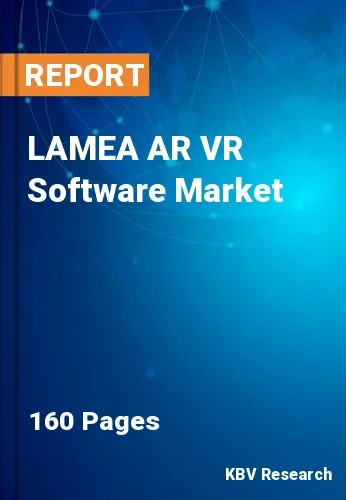The Latin America, Middle East and Africa AR VR Software Market would witness market growth of 20.4% CAGR during the forecast period (2023-2030).
The AR (Augmented Reality) and VR (Virtual Reality) software is a dynamic and rapidly growing sector within the broader technology industry. It encompasses software applications and platforms that enable the creation, development, and deployment of AR and VR experiences. This market is driven by the increasing adoption of AR and VR technologies in various industries and applications, including gaming, education, healthcare, retail, manufacturing, and more.
The gaming industry, while already established in the AR and VR sector, continues to drive innovation. The development of immersive and highly realistic gaming experiences has attracted a dedicated and expanding user base. These technologies offer players the opportunity to step into virtual worlds, making gaming more immersive and engaging than ever before. Hardware advancements, such as more powerful VR headsets and controllers, have further enriched the gaming experience.
In South Africa, the "Digital School" project stands out as an example of government investment in AR and VR for education. This program introduces VR-based educational content into schools to enhance learning experiences. By creating virtual classrooms and interactive lessons, the government aims to bridge educational disparities and provide equal access to quality education across the country.
Saudi Arabia's "Vision 2030" initiative includes substantial funding for AR and VR projects, such as the "SaudiVR" program. This initiative is focused on diversifying the economy and fostering innovation. One notable aspect is the use of VR for cultural preservation and entertainment, with the development of virtual museums and immersive cultural experiences. The government's investment in these programs reflects its commitment to embracing modern technology while preserving its rich heritage. Therefore, the region presents lucrative growth prospects for the market.
The Brazil market dominated the LAMEA AR VR Software Market by Country in 2022, and would continue to be a dominant market till 2030; thereby, achieving a market value of $1,737.4 Million by 2030. The Argentina market is experiencing a CAGR of 21% during (2023 - 2030). Additionally, The UAE market would exhibit a CAGR of 20.1% during (2023 - 2030).
Based on Vertical, the market is segmented into Media & Entertainment, Training & Education, Travel & Hospitality, Manufacturing, Healthcare, Aerospace & Defense, Real Estate, Automotive, Retail & E-commerce, and Others. Based on Technology Type, the market is segmented into AR Software, and VR Software. Based on Software Type, the market is segmented into Software Development Kit, Game Engine, Modeling & Visualization Software, Content Management System, Training & Simulation Software, and Others. Based on countries, the market is segmented into Brazil, Argentina, UAE, Saudi Arabia, South Africa, Nigeria, and Rest of LAMEA.
Free Valuable Insights: The Worldwide AR VR Software Market is Projected to reach USD 97.3 Billion by 2030, at a CAGR of 18.1%
The market research report covers the analysis of key stake holders of the market. Key companies profiled in the report include Microsoft Corporation, Google LLC, Magic Leap, Inc., Adobe, Inc., Autodesk, Inc., NVIDIA Corporation, Advanced Micro Devices, Inc., Qualcomm, Inc., Zoho Corporation Pvt. Ltd., and Hexagon AB.
By Vertical
By Technology Type
By Software Type
By Country
Our team of dedicated experts can provide you with attractive expansion opportunities for your business.

